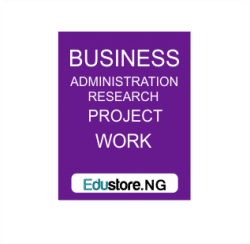CHAPTER ONE
INTRODUCTION
- Background of the study
A business firm or organization has a number of considerable factors that enables it to grow or expand. Beginning from the location of the business to the demand and supply of goods and services, the interest of this research work hinges on the quality of goods and services supplied to customers or consumers (quality of service delivery). A proprietor of any business firm, especially in a competitive environment and season, must bear in mind that other proprietors in the same line of business are in serious pursuit of profit.
Therefore, in order to beat the lead, one must consider the quality of goods and services supplied rendered to the consumer’s. In the light of this, the welfare of employees or worker is very essential. The workforce of every business is now other than “human capital”. Human capital is a factor that either triggers a business firm to yield profit even in abundance or make same to run at a hinge loss. This research therefore, focuses on advantages (impact) of human capital development as a panacea of any successful business. It will also consider ways of enhancing human capital development programmes. The human capital of an organization consist of the people who work and on whom the success is increasingly correlated with the possession of materials skills. Skilled individuals can command a premium salary in periods of high economic activity. Worldwide, unemployment level remains high while organizations have difficulty in filling vacancies that require specific expertise.
In current global market, companies are composed by competitors, regardless of industry. To develop a competitive advantage, it is important that firms truly leverage on the workforce as a competitive weapon. A strategy for improving workforce productivity to drive higher value for the firms has become an important focus. Firms seek to optimize their workforce through comprehensive human capital development programmes not only to achieve business goals but most important is for a long term survival and sustainability. To accomplish this undertaking, firms will need to invest resources to ensure that employees have the knowledge, skills, and competencies they need to work effectively in a rapidly changing and complex environment.
In response to the changes, most firms have embraced the notion of human capital has a good competitive advantage that will enhance higher performance. Human capital development becomes a part of an overall effort to achieve cost-effective and firm performance. Hence, firms need to understand human capital that would enhance employee satisfaction and improve performance. Although there is a broad assumption that human capital has positive effects on firms’ performance, the notion of performance for human capital remains largely untested. Hence, this paper attempts to look into the connection between human capital and firm’s performance in the development economics. Therefore, the following research question is used to guide our investigation: To what extent does human capital impact on firm performance?
While much of the argument in the literature in terms of factors contributing to performance, this paper looks at one of the factors i.e. human capital. Firm performance is a common issue in any organizations in Malaysia especially in the new era of globalization, where competitiveness and innovativeness are norms that go with performance.
This literature-based paper begins by defining the concepts of human capital and firm performance. It then explores the human capital theory and connection between human capital and firm performance. In the final section we develop the model and conclude the significance of the human capital as a pillar in future analysis of firm performance.
According to Sullivan and Steven (2003) Human capital development is about recruiting, supporting and investing in people through education, training, coaching mentoring internships, organizational development and human resources management. Human capital development recognizes that the development and growth of people in organizations and business are an important and essential asset to the organizations future success.
Healthfield (2011) defined human capital development as the framework for helping employees develop their personal and organizational skills, knowledge and ability. According to her, human capital development includes such opportunities as employee training, employee
DOWNLOAD COMPLETE WORK- For Reference Only: Materials are for research, citation, and idea generation purposes and not for submission as your original final year project work.
- Avoid Plagiarism: Do not copy or submit this content as your own project. Doing so may result in academic consequences.
- Use as a Framework: This complete project research material should guide the development of your own final year project work.
- Academic Access: This platform is designed to reduce the stress of visiting school libraries by providing easy access to research materials.
- Institutional Support: Tertiary institutions encourage the review of previous academic works such as journals and theses.
- Open Education: The site is maintained through paid subscriptions to continue offering open access educational resources.






